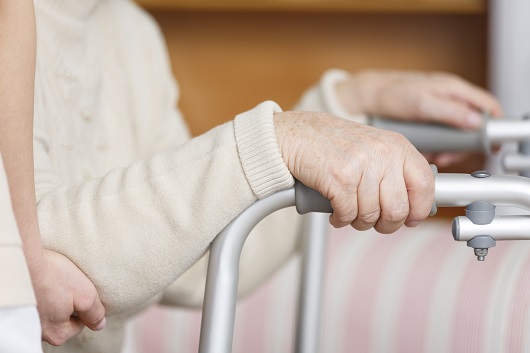Parkinson’s disease is one of the top three diseases of the elderly, along with dementia and stroke. As the population ages, the incidence is increasing worldwide. However, recent research has shown that having both ovaries removed before menopause may increase the risk of developing Parkinson’s disease, a disease of the central nervous system, several years later.
Parkinson’s disease is more common in women than men. ㅣSource: Getty Image Bank
Parkinson’s disease, a degenerative disease in women
Because there are more outbreaks
Parkinson’s disease is a disease of the central nervous system in which movement disorders such as muscle stiffness, body tremors, and slow movements are caused by the loss of cells that produce dopamine, a neurotransmitter secreted in areas of the brain that control movement.
“Parkinson’s disease shows movement disorders such as abrasions (slow movements), tremors at rest, muscle stiffness and gait disturbances,” said Dr. Kyung-Pil Oh (Mediin Hospital), neurology consultant at Haidak. he said. Additionally, he said, “If symptoms of Parkinson’s disease are found, a detailed examination should be done through a neurologist, and symptoms can be controlled through medication control.”
According to the current status of Parkinson’s disease treatment in Korea announced by the National Health Insurance Corporation (health insurance treatment data), the number of people treated for Parkinson’s disease in 2020 was 111,312, compared to 96,764 in 2016 , five years ago, of 14,548 (15%). ) increased. This is an average annual increase of 3.6%. There were 46,369 male patients and 64,943 female patients, 16% (18,574) more female patients than male patients.
Looking at the composition of the number of people treated by age group, 37.9% (42,172 people) were 70 years old, followed by 36.5% (40,603 people) over 80 and 18.7% (20,819 people ) in his sixties. appeared as Parkinson’s disease appears to be more common in women over the age of 70. Why is Parkinson’s disease more common in women?
In women who underwent oophorectomy before the age of 43
5-fold higher incidence of Parkinson’s disease
In October 2022, a research team led by Dr. Walter A. Rocca, a neurologist at the Mayo Clinic in the United States, published in JAMA Network Open, a journal of the American Medical Association, that bilateral premenopausal oophorectomy is associated with the Parkinson’s disease research findings that are related.
The research team compared the medical records of 2,750 women who had bilateral oophorectomy between 1950 and 2007 with those of 2,750 women of similar age who had not had oophorectomy. Consequently, there were 32 Parkinson’s disease patients in the group in which both ovaries were resected and 21 in the control group in which neither ovary was resected. Parkinsonism, a degenerative disease with symptoms similar to Parkinson’s disease, occurred in 50 patients in the oophorectomy group and 32 patients in the control group.
According to the study, women who had both ovaries removed before the age of 43 were five times more likely to develop Parkinson’s disease than women in the same age group who did not have their ovaries removed. However, women who underwent oophorectomy when they were older did not have an increased risk of Parkinson’s disease.
The research team explained: “This supports the theory that early withdrawal of the female hormone estrogen may increase the risk of Parkinson’s disease.” The ovaries are the main source of estrogen in the female body. When both ovaries are removed before menopause, estrogen levels drop suddenly. In other words, the ability of estrogen to protect the brain is lost. Therefore, Parkinson’s disease is twice as common in women as in men. The research team said: ‘This suggests that estrogen, a female hormone, has the effect of protecting dopamine, a neurotransmitter in the brain associated with Parkinson’s disease.’ Rather, it increases the risk of Parkinson’s disease.”
Oophorectomy is performed to reduce the risk of ovarian cancer or benign tumors in the ovaries, such as ovarian cysts. Right now, there are cases where the ovaries are also removed for the purpose of preventing ovarian cancer, and this study found that premenopausal oophorectomy increases the risk of Parkinson’s disease.
Dopamine is key to relieving the symptoms of Parkinson’s disease
Parkinson’s disease is one of the degenerative brain diseases and aging is the main risk factor. There are currently no drugs that can halt or reverse the progression of Parkinson’s disease. However, the medications currently used help control the symptoms. In general, drugs such as pramipexole, ropinirole and apomorphine mimic the function of dopamine in the brain to relieve tremors and control movement. This determines the type and dosage of the medicine in consideration of the patient’s age, activity level and side effects. Therefore, it is necessary to consult a neurologist on a regular basis about symptoms.
The key to treating Parkinson’s disease is to supplement dopamine, which is lacking. If the patient takes a drug that can affect dopamine transmission, the patient’s symptoms may worsen. Also, if there is no response to the drug or if the drug is difficult to take due to severe side effects, the patient may be evaluated and surgical treatment, Deep Brain Stimulation may be considered.
<저작권©언론사 하이닥, 무단 전재 및 재배포 금지>


